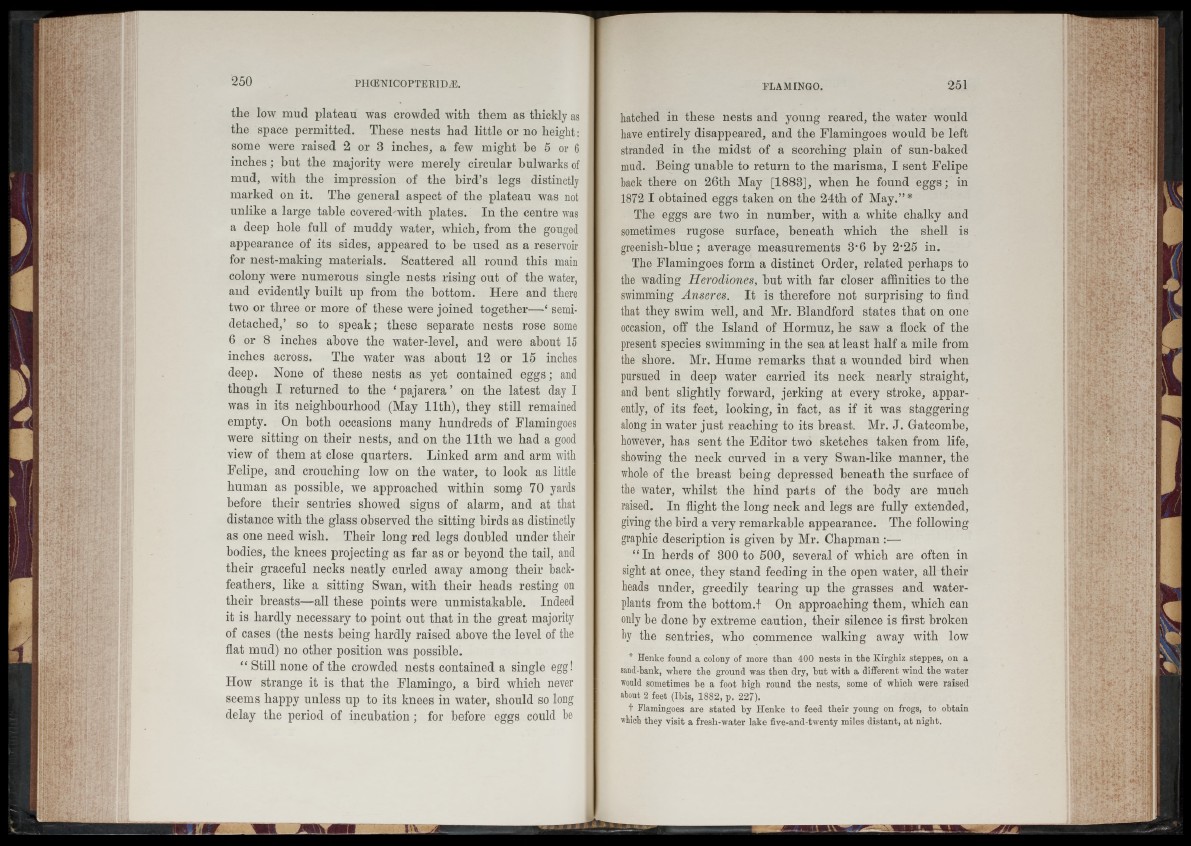
the low mud plateau was crowded with them as thickly as
the space permitted. These nests had little or no height:
some were raised 2 or 3 inches, a few might be 5 or 6
inches; hut the majority were merely circular bulwarks of
mud, with the impression of the bird’s legs distinctly
marked on it. The general aspect of the plateau was not
unlike a large table covered with plates. In the centre was
a deep hole full of muddy water, which, from the gouged
appearance of its sides, appeared to be used as a reservoir
for nest-making materials. Scattered all round this main
colony were numerous single nests rising out of the water,
and evidently built up from the bottom. Here and there
two or three or more of these were joined together—£ semidetached,’
so to speak; these separate nests rose some
6 or 8 inches above the water-level, and were about 15
inches across. The water was about 12 or 15 inches
deep. None of these nests as yet contained eggs; and
though I returned to the ‘ pajarera ’ on the latest day I
was in its neighbourhood (May 11th), they still remained
empty. On both occasions many hundreds of Flamingoes
were sitting on their nests, and on the 11th we had a good
view of them at close quarters. Linked arm and arm with
Felipe, and crouching low on the water, to look as little
human as possible, we approached within somg 70 yards
before their sentries showed signs of alarm, and at that
distance with the glass observed the sitting birds as distinctly
as one need wish. Their long red legs doubled under their
bodies, the knees projecting as far as or beyond the tail, and
their graceful necks neatly curled away among their back-
feathers, like a sitting Swan, with their heads resting on
their breasts—all these points were unmistakable. Indeed
it is hardly necessary to point out that in the great majority
of cases (the nests being hardly raised above the level of the
flat mud) no other position was possible.
“ Still none of the crowded nests contained a single egg!
How strange it is that the Flamingo, a bird which never
seems happy unless up to its knees in water, should so long
delay the period of incubation; for before eggs could he
hatched in these nests and young reared, the water would
have entirely disappeared, and the Flamingoes would be left
stranded in the midst of a scorching plain of sun-baked
mud. Being unable to return to the marisma, I sent Felipe
back there on 26th May [1883], when he found eggs; in
1872 I obtained eggs taken on the 24th of May.” *
The eggs are two in number, with a white chalky and
sometimes rugose surface, beneath which the shell is
greenish-blue ; average measurements 3‘6 by 2*25 in.
The Flamingoes form a distinct Order, related perhaps to
the wading Herodiones, but with far closer affinities to the
swimming Anseres. It is therefore not surprising to find
that they swim well, and Mr. Blandford states that on one
occasion, off the Island of Hormuz, he saw a flock of the
present species swimming in the sea at least half a mile from
the shore. Mr. Hume remarks that a wounded bird when
pursued in deepo water carried its neck nearly straight,
and bent slightly forward, jerking at every stroke, apparently,
of its feet, looking, in fact, as if it was staggering
along in water just reaching to its breast. Mr. J. Gatcombe,
however, has sent the Editor two sketches taken from life,
showing the neck curved in a very Swan-like manner, the
whole of the breast being depressed beneath the surface of
the water, whilst the hind parts of the body are much
raised. In flight the long neck and legs are fully extended,
giving the bird a very remarkable appearance. The following
graphic description is given by Mr. Chapman :—
“ In herds of 300 to 500, several of which are often in
sight at once, they stand feeding in the open water, all their
heads under, greedily tearing up the grasses and water-
plants from the bottom.f On approaching them, which can
only be done by extreme caution, their silence is first broken
by the sentries, who commence walking away with low
* Henke found a colony of more than 400 nests in the Kirghiz steppes, on a
sand-bank, where the ground was then dry, hut with a different wind the water
would sometimes he a foot high round the nests, some of which were raised
about 2 feet (Ibis, 1882, p. 227).
t Flamingoes are stated hy Henke to feed their young on frogs, to obtain
which they visit a fresh-water lake five-and-twenty miles distant, at night.